Any two colors that are diagonally opposite to each other on the color wheel are called complementary colors. For example, a blue color is complementary to orange, red to green and yellow to purple. When you place to complementary colors next to each other they have a strong influence on one another.
Watercolor painting with complementary colors can be very expressive and with careful choice of colors, you can achieve amazing results. For example, a little speck of red on a big field of green can achieve that both green and red look more lively and bright. The visual effect of complementary colors is very strong and with careful use of those in your paintings, you can achieve very dramatic results.
The reason for the effectiveness of complementary colors is in the way human eye functions. For example, if you stare at bright red for about 20 seconds and then you divert your eyes to a white surface you will see green image on the paper and vice versa.
Use the complementary contrast to your advantage to give some sharpness and brightness to your paintings. Paint specks of red or red-brown in the fields of green leaves or grass and that will make them look lively. When placed next to each other, complementary colors form bright eye appealing area which draws attention to a certain part of your composition.
Also, use complementary colors in some of the shadows to create a clearer shadow. Orange will, for example, cast a shadow with blueish nuance and red apple will cast a shadow that has green nuance. If you mix to complementary colors they will neutralize each other and give you a variety of greys that are far more subtle and interesting that the greys you get by mixing black and white.
These neutral greys give a very nice base for brighter colors and are never too bright.
Evening Shadows
To complete this painting you will need the following:
- One sheet of cold pressed 285g/m2 watercolor paper
- Round sable brush number 4
- Round sable brush number 8
- Small piece of fine sandpaper
And the following colors:
- French Ultramarine
- Cadmium Red
- Alizarine Red
- Cadmium Yellow
- Lemon Yellow
- Raw Sienna
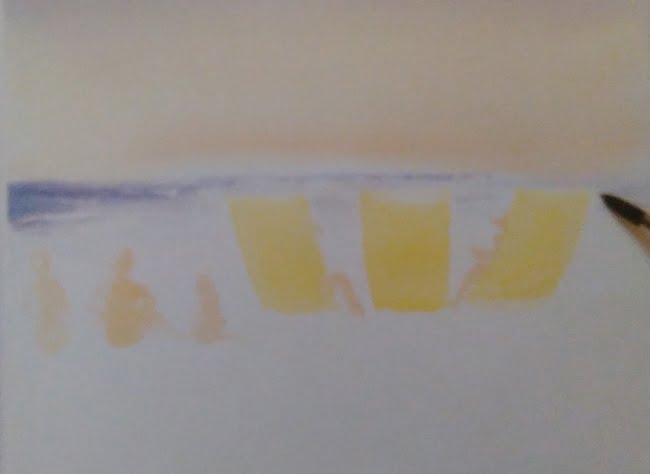
Sketching
Using round sable brush number 8 paint the beach loungers with diluted lemon yellow. Mix pale flesh color using diluted lemon yellow and alizarine red and use it to suggest shapes of people and a dog on the beach and people sitting in the loungers like simple silhouettes.
Leave the sketch to dry and then ad a new layer of paint to shape figures with light and shadow.
Paint the evening sky using multiple colors. First, lean the painting board at an angle and soak the area of the sky with water.
Using well-soaked round sable brush number 8 ad very diluted cadmium yellow across the entire area of the sky.
While it is still wet paint a line of French ultramarine on the upper edge of the paper and one line of alizarine red near the horizon. The paint will subtly mix to give the impression of the misty sky.
Paint the sea with French ultramarine with just a little bit of alizarine red added to it and dilute the paint with more water in the front plane.
When you’re painting with many different spreads it takes a little bit of experience to get a smooth transition from one color to the other. The secret is in the wet brush and confident swift strokes.
Using French ultramarine with a bit of alizarine red here and there, to paint the long shadows that the loungers and human figures are casting.
While you are painting use different tones making them paler the farther the shadow is from the object that’s casting it.
With round sable brush number 4 and a darker mixture of ultramarine and alizarine red paint the beach toys on the left side of the painting and the shadows they are casting.



Adding the details
It is time to add some details. Use French ultramarine to paint mens’ bathing suits and diluted cadmium red to paint womens’ bathing suit and straw hat.
Add a bit of alizarine red in the shadow the female is casting letting it spread through the shadow creating the reflection of the light.
Use the same colors to paint the red and blue stripes on the beach loungers this time using the round sable brush number 8.
Take the round sable brush number 4 and paint the sun umbrella using cadmium yellow, cadmium red and French ultramarine.
With the purple, you got by mixing all three colors paint the wavey rim of the sun umbrella and the pole holding it.
Mix a pale mixture of French ultramarine and use it to paint the shadows of the people that are sitting in the beach loungers.
When you are painting human figures in the landscape remember not to add too many details to them because that will make them look lifeless and stiff.
Try to capture the shapes of the figures and the movement simply and quickly.
Start adding more details to the figures that are sitting on the sand, emphasizing on the shadows using transparent spreads of French ultramarine.
Create a dark mixture of French ultramarine and alizarine red and work on the hat and dark tones on the dog.
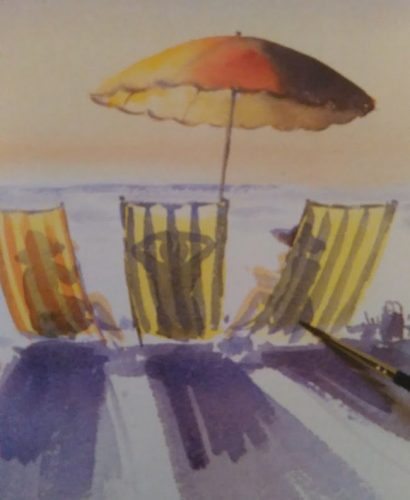
Mix warm grey using French ultramarine and a little bit of alizarine red and use it to paint the foggy shape of the island in the distance.
Now paint the sandy beach using the mixture of raw sienna, cadmium yellow and tiny drop of cadmium red touching with your brush here and there around the human figures.
Strengthen the tone in the front plane with more cadmium red adding the paint over the painted shadow.
Sketch a glimpse of the frames of the beach loungers
using French ultramarine and round sable brush number 4. Add more French ultramarine in the shadows on the sand to create the impression of double shadows.
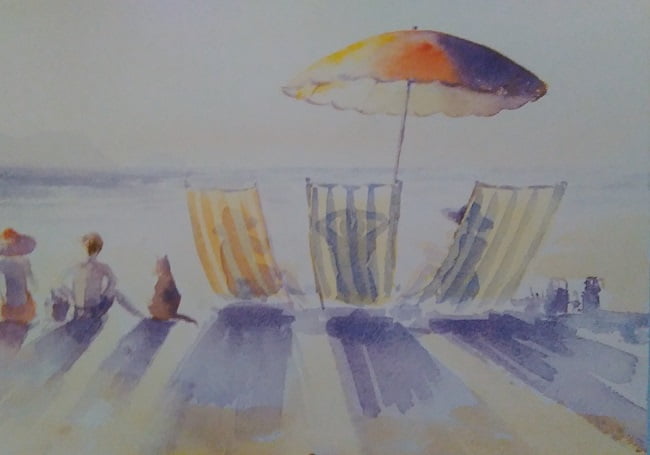

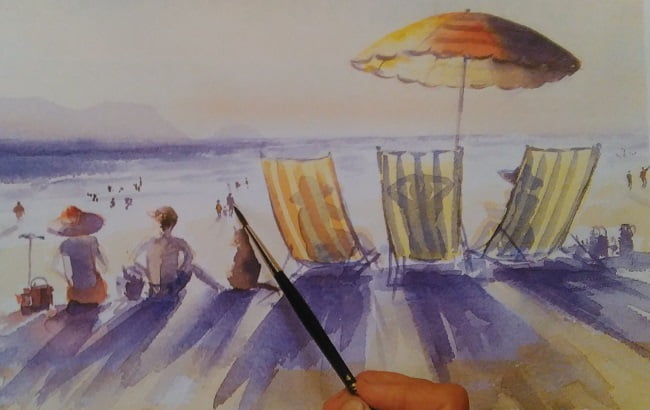
Finishing touches
Now when the painting is developed the sky might look a little bit empty. If that is the case go over it one more time using the same colors as you did the first time and round sable brush number 8.
Use dots and smears of French ultramarine and alizarine red added with round sable brush number 4 to depict groups of people walking down the beach in the distance.
Use smaller less accurate moves for the human figures in the water. Downsizing gives your painting a sense of depth and space. Leave the painting to dry.
Check to see if your painting is fully dry and then create the impression of the sparkling sunlight on the open sea. To achieve that bend small piece of fine sandpaper and with the rim of it scrape some dried paint.
Do that very gently so you remove only the color from the top of the surface of the paper leaving a strain of scattered white areas.
Drag the sandpaper in one direction only making sure you don’t tare the paper.
This is just one example of using complementary colors. You can always experiment and see what results you will get. If you have any questions and need help you can leave them below and I will be more than happy to answer them.

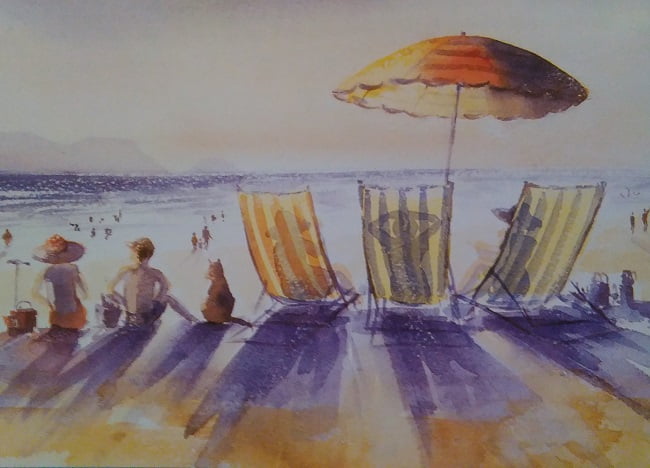



0 Comments